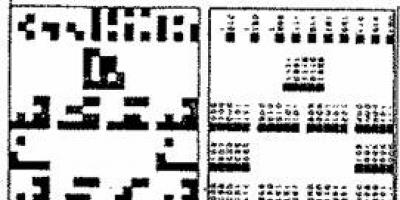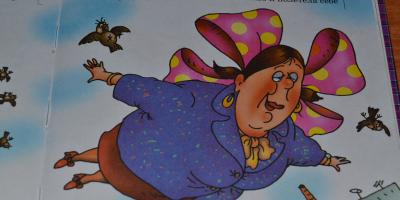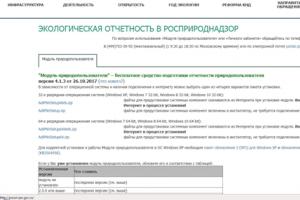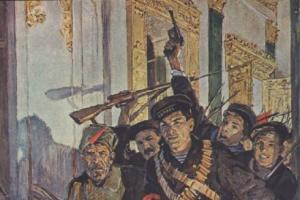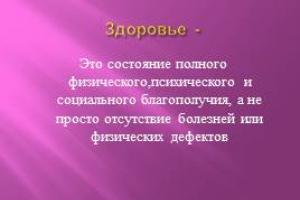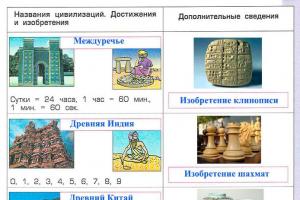Exactly 70 years ago - on May 11, 1944 - the State Committee issued a resolution on the beginning of the Stalinist deportation of the Crimean Tatars in 1944 - the eviction of the indigenous population of the Crimean peninsula to Tajikistan, Kazakhstan and Uzbekistan...
Among the reasons for the deportation of the Crimean Tatars from Crimea, their collaboration during the Second World War was also mentioned.
Only in the late perestroika years was this deportation recognized as criminal and illegal.
The formally stated reason for the deportation of the Crimean Tatars in 1944 was the complicity of the Germans by part of the population of Tatar nationality in the period from 1941 to 1944, during the seizure of Crimea by German troops.
From the Resolution of the State Defense Committee of the USSR dated May 11, 1944, the full list is stated - treason, desertion, defection to the side of the fascist enemy, the creation of punitive detachments and participation in brutal reprisals against partisans, mass extermination of residents, assistance in sending groups of the population into slavery in Germany , as well as other reasons for the deportation of the Crimean Tatars in 1944, carried out by the Soviet authorities.
Among the Crimean Tatars, 20 thousand people either belonged to police detachments or were in service in the Wehrmacht.
Those collaborators who were sent to Germany before the end of the war to create the Tatar SS Mountain Jaeger Regiment managed to avoid Stalin's deportation of the Crimean Tatars from Crimea. Among those Tatars who remained in Crimea, the bulk were identified by NKVD employees and convicted. During the period from April to May 1944, 5,000 accomplices of the German occupiers of various nationalities were arrested and convicted in Crimea.
The part of this people that fought on the side of the USSR was also subjected to Stalin’s deportation of the Crimean Tatars from Crimea. In a number of (not so numerous) cases (as a rule, this affected officers with military awards), Crimean Tatars were not expelled, but a ban was imposed on them from living in the territory of Crimea.
Over two years (from 1945 to 1946), 8,995 war veterans belonging to the Tatar people were deported. Even that part of the Tatar population that was evacuated from Crimea to the Soviet rear (and, of course, for which it was impossible to find a single reason for the deportation of the Crimean Tatars in 1944) and could not be involved in collaborationist activities, was deported. The Crimean Tatars, who held leading positions in the Crimean Regional Committee of the All-Union Communist Party and the Council of People's Commissars of the KASSR, were no exception. As a reason, the thesis was put forward about the need to replenish the leadership of government bodies in new places.
The Stalinist deportation of Crimean Tatars from Crimea, based on national criteria, was characteristic of political totalitarian regimes. The number of deportations, when only nationality was taken as a basis, in the USSR during the reign of Stalin, according to some estimates, is close to 53.

The operation to deport the Crimean Tatars was planned and organized by the NKVD troops - a total of 32 thousand employees. By May 11, 1944, all clarifications and adjustments were made in the lists of the Crimean Tatar population, and their residential addresses were checked. The secrecy of the operation was the highest. After the preparatory operations, the deportation procedure itself began. It lasted from May 18 to May 20, 1944.
Three people - an officer and soldiers - entered houses early in the morning, read out the reasons for the deportation of the Crimean Tatars in 1944, gave a maximum of half an hour to get ready, then the people who were literally thrown out onto the street were collected into groups and sent to railway stations.
Those who resisted were shot right next to their houses. At the stations, about 170 people were placed in each heated carriage, and the trains were sent to Central Asia. The road, exhausting and difficult, lasted about two weeks.
Those who managed to take food from home could barely survive; the rest died from hunger and diseases caused by the transportation conditions. First of all, the elderly and children suffered and died. Those who could not bear the crossing were thrown off the train or hastily buried near the railway.
From the memories of eyewitnesses:

Official data sent to Stalin for reporting confirmed that 183,155 Crimean Tatars were deported. Crimean Tatars who fought were sent to the labor armies, and those demobilized after the war were also deported.
During the deportation period from 1944 to 1945, 46.2% of Crimean Tatars died. According to official reports from Soviet authorities, the death toll reaches 25%, and according to some sources - 15%. Data from the OSP of the Ukrainian SSR indicate that in the six months since the arrival of the trains, 16,052 displaced persons died.
The main destinations of the trains with deportees were Uzbekistan, Kazakhstan and Tajikistan. Also, some were sent to the Urals, the Mari Autonomous Soviet Socialist Republic and the Kostroma region. The deportees had to live in barracks that were practically not intended for living. Food and water were limited and conditions were almost unbearable, causing many deaths and illnesses among those who survived the move from Crimea.

Until 1957, the deportees were subject to a special settlement regime, when it was prohibited to move further than 7 km from home, and each settler was obliged to report monthly to the commandant of the locality. Violations were punished extremely strictly, including long terms in camps, even for unauthorized absence to a neighboring settlement where relatives lived.
The death of Stalin did little to change the situation of the deported Crimean Tatar population. All those repressed on ethnic grounds were conditionally divided into those who were allowed to return to the autonomy, and those who were deprived of the right to return to their places of original residence. The so-called policy of “rooting” exiles in places of forced settlement was carried out. The second group included the Crimean Tatars.
The authorities continued the line of accusing all Crimean Tatars of aiding the German occupiers, which provided a formal basis for banning the return of settlers to Crimea. Until 1974, formally and until 1989 – in fact – Crimean Tatars could not leave their places of exile. As a result, in the 1960s, a broad mass movement arose for the return of rights and the possibility of returning Crimean Tatars to their historical homeland. Only during the process of “perestroika” did this return become possible for the majority of deportees.
Stalin's deportation of Crimean Tatars from Crimea affected both the mood and the demographic situation of Crimea. For a long time, the population of Crimea lived in fear of possible deportation. They added panic expectations and evictions of Bulgarians, Armenians and Greeks living in Crimea. Those areas that were inhabited by Crimean Tatars before the deportation remained empty. After returning, most of the Crimean Tatars were resettled not to their previous places of residence, but to the steppe regions of Crimea, whereas previously their homes were in the mountains and on the southern coast of the peninsula.
Speaking recently at a forum dedicated to the 70th anniversary of the adoption of the Universal Declaration of Human Rights, Petro Poroshenko went so far as to compare the Russian government in Crimea (without failing to label it, as usual, “occupation”) with “the actions of Stalin, who dreamed of destroying the Tatar people " Said loudly... And also deceitful and illiterate. In general, very Poroshenko-like. However, in order to fully understand what nonsense the Ukrainian president spouted, it is necessary to thoroughly understand the true essence of the events of the spring of 1944 in Crimea, and, above all, their prerequisites and reasons.
On May 10, 1944, the Chairman of the State Defense Committee of the USSR Joseph Stalin signed a decree “On the Crimean Tatars”, on the basis of which 190 thousand representatives of this nationality were evicted from the peninsula within literally the next 10 days. The place of deportation was mainly Uzbekistan, however, some of them ended up in Kazakhstan and other republics of the USSR. About one and a half thousand Tatars remained on the territory of Crimea - participants in the anti-Hitler underground, partisans and those who fought in the Red Army, as well as members of their families.
Tragic story? Without a doubt. However, before shedding tears over its participants, declaring them, every single one, “innocent victims of Stalinism,” let us go back even further in time - to 1941. It was then that the foundation was laid for the events that happened three years later - and by none other than the Crimean Tatars themselves. In the memo of the People's Commissar of Internal Affairs of the USSR Lavrentiy Beria, which, in fact, became the basis for the adoption of the above-mentioned decision of the State Defense Committee, everything was stated with Beria's merciless accuracy and directness. No “lyrics” – only numbers and facts.
Do you want to know how many Crimean Tatars deserted from the ranks of the 51st Army, which was retreating from Crimea? 20 thousand. How many of them were drafted into the Red Army? There were exactly 20 thousand... A wonderful example of betrayal, unparalleled, one might say! One hundred percent desertion in itself speaks volumes. But if only, having scattered like cockroaches before the advancing Nazis, the Tatars had stopped there! It wasn't like that at all. Before the invaders had time to enter Crimea, representatives of the Tatars had already rushed to them with expressions of complete devotion and assurances that they were all ready to faithfully serve “Adolf Effendi”, recognizing him as their leader.
Such zeal was favorably received by the Nazi leaders, which was reported in the first days of 1942 at the first meeting of the Tatar Committee, held in captured Simferopol. Heroic Sevastopol was still fighting, bleeding, but not surrendering, and the Crimean mullahs were already howling prayers for the health of the “great Fuhrer”, the “invincible army of the great German people” and the repose of the vile little souls of the murderers from the Wehrmacht. Having prayed, they set to work - security, police and auxiliary units of the Nazis were formed en masse from the Crimean Tatars. They were especially valued in the SD and field gendarmerie.
Many mournful words have been written and spoken about the death camp, which was located during the war on the territory of the Krasny state farm near Simferopol. With its horrors it earned the name “Crimean Dachau”. At least 8 thousand people were shot there alone. However, much less was mentioned about the fact that there were, strictly speaking, two Germans among the executioners in this terrible place - the “doctor” of the camp and its commandant. The rest of the “personnel” consisted of Crimean Tatars who served in the 152nd SD Shuma battalion. This unit, by the way, was formed exclusively on a voluntary basis. The rabble gathered in it showed simply incredible ingenuity in relation to torture and executions. I’ll give just one example - one of these “know-hows” was the extermination of people who were stacked in piles, tied with barbed wire, doused with gasoline and set on fire. Particular luck in this case was to get into the very bottom layer - there was a chance to suffocate before the flame broke out...
The real nightmare of the Crimean partisan detachments were the Tatar guides of the fascist Jagd teams and punitive detachments that hunted for them. Perfectly oriented to the terrain, knowing, as they say, every stone, every path in the mountains, these non-humans over and over again led the Nazis to the places where our soldiers were hiding, their camps and sites. This kind of “specialists” turned out to be so in demand for the Third Reich that in 1944, having abandoned part of their troops in Crimea, the Germans found the opportunity to evacuate them from the peninsula by sea, subsequently forming first the Tatar SS Mountain Jaeger Regiment, and then an entire brigade. A huge honor...
There is still a lot to remember. About the stones that flew at our prisoners when they were driven through Tatar villages... About two hectares of Crimean land, which were given to each of the Tatars who entered the service of the occupiers, and which was taken away from the Russian people. About how desperately the Tatar battalions fought near Bakhchisarai and Islam-Terek in 1944, trying to stop the Red Army going to liberate Crimea. About the zeal with which they searched for and destroyed communists throughout the peninsula, wounded Red Army soldiers whom residents tried to hide, as well as Jews and Gypsies, in whose extermination they took an active part.
Doesn’t it occur to anyone that by deporting the Tatars from Crimea, among whom at least every tenth was not only tainted by collaboration with the invaders, but had their hands covered in blood up to their elbows, Stalin and Beria did not destroy them, but saved them?! The veterans returning from the fields of the Great Patriotic War a year or two later would hardly have limited themselves to “verbal censure” of the traitors...
It is impossible not to mention one more point. The “international human rights organizations” and other liberal riffraff that annually shed streams of tears over the “undeservedly deported” Crimean Tatars, for some reason do not cry over other completely similar stories of the same time. Over the internment of 120 thousand Japanese, as well as thousands of Germans and Italians who were driven behind the “thorn” in 1941 in the USA. Note - not for any specific crimes, and not even “on suspicion”. Simply - for nationality! And there is no groaning over the 600 thousand Germans who perished during their mass eviction from European countries after the end of the Second World War. The infections are silent, like fish on ice...
But the Germans - not Nazis, not Wehrmacht or SS veterans, but simply those who had the misfortune of belonging to this nation - were driven out of Czechoslovakia, Hungary, Poland, Yugoslavia in the millions in 1945! 500-600 thousand is only the documented number of those killed during deportation.
I do not condemn or justify anyone. It was just such a time - cruel, bloody, terrible... And some things that today cause a shudder with their categoricalness and their scale were completely normal for him, almost universal practice. This is all to say that declaring the deportation of 1944 the pinnacle of world atrocities is incorrect, to say the least.
Regarding the fact that in the spring of 1944 it was entirely “innocent” and “uninvolved” who were arrested and deported... Only enough small arms were confiscated during the eviction operation to arm an infantry division! Okay, ten thousand (!) rifles... And more than 600 machine guns and mortars - fifty? Why were they hiding all this?! Shoot at sparrows? Even before the deportation began, stern comrades in cornflower blue caps from Beria’s department captured more than 5 thousand representatives of the Crimean Tatar population, whose connection with the Nazis was so obvious, and their crimes so bloody, that most of them, without ceremony, had a noose thrown around their necks. Among them, there were many spies, saboteurs and simply “sleeping” agents who were trying to hide, left in the liberated territory with very specific tasks from the fascist masters.
I agree that the whole nation cannot be guilty. Nobody accuses an entire people... Let's not dive into emotions, but turn to dispassionate and dry arithmetic. I will give some figures, and everyone is free to draw the following conclusions themselves.
First of all, no matter what the extremists entrenched in Ukraine and their accomplices are trying to say now, Crimea was by no means Tatar before the Great Patriotic War. Ukrainian, by the way – even more so! According to the 1939 census, more than half a million Russians, more than 200 thousand Tatars, and a little more than 150 thousand Ukrainians lived on the peninsula. Well, and representatives of other nationalities - Armenians, Greeks, Jews, Bulgarians, in much smaller quantities.
Of these same 200 thousand, according to a careless decision made by the leaders of the Tatar Committee operating under the occupiers, 20 thousand served the Nazis with weapons in their hands. Every tenth... However, according to many historians, the figure is ungodly underestimated - at least 35-40 thousand Crimean Tatars actually collaborated with the fascists (not only in the ranks of the SS, SD and police, but also as guides, informants and servants). Every fifth... During the deportation, out of 191 thousand transported, according to the NKVD report, 191 people died en route. One in a thousand... This is not a comparison. This is just basic arithmetic.
During the Nazi occupation in Crimea, at least 220 thousand of its inhabitants were destroyed and driven into slavery, and 45 thousand Red Army soldiers who were captured died in the fascist dungeons and camps located on its territory. There were no Crimean Tatars among them. On the other hand, punishers, policemen, and guards from Tatar formations who faithfully served the invaders were fully involved in all these crimes. They made their conscious choice and everything that happened later was retribution for it. At the same time, there were no mass executions, no wholesale sending of all Tatars to camps - only expulsion.
Have the people, whose sons flooded the land of Crimea with the blood of those who lived peacefully on it next to them, lost the right to walk on this land? Everyone can find their own answer to this question. Stalin just found his...
Irina Simonenko
Every year on May 18, Crimean Tatars celebrate the Day of Remembrance for Victims of Deportation. Through the efforts of Ukrainian political strategists and their curators, from the original day of grief of the deportation of the Crimean peoples, this day methodically and purposefully turned into the Day of Remembrance of the victims of the exclusively Crimean Tatar, “punished without guilt” people.
The words of Petro Poroshenko are especially cynical: “We are obliged to give the Crimean Tatars the right to self-determination within the framework of a single Ukrainian state. This is what we owe the Crimean Tatars. The Ukrainian authorities should have done this at least 20 years ago. And now the situation would be completely different.”
By the way, no matter how much the “representatives” of the Kyiv Crimean Tatars ask and plead, they will never receive that same definition. For Kyiv, these people have always been a tool for manipulation. And in the entire history of Ukraine, things have not gone beyond promises, only time after time “the need to amend Section 10 of the Constitution of Ukraine is emphasized,” but in reality this will never be allowed.
Ukraine consists of different regions that once belonged to the Polish-Lithuanian Commonwealth, Turkey, and the Russian Empire. And if the Crimean Tatars receive self-determination, which the Guarantor of the Constitution enthusiastically talks about every May 18, then they are quite capable of wanting the same “autonomy” in Transcarpathia. And there, further along the chain, Square may lose all its lands.
Ukrainian politicians continue to lead the Crimean Tatar people by the nose by promising their land, their government and mountains of gold. But even on paper, they still do not want to formalize such changes in relation to the already lost territory of Crimea, postponing the adoption of the document for another year, two, three. And so on ad infinitum.
Today, the number of historical hoaxes associated with the “Stalinist expulsion of peoples” is only growing and bottom experts are already calling it “planned genocide.”
It will not be superfluous to understand this issue. What were the reasons for the deportation? What actually happened on the territory of Crimea during the war? There are very few living witnesses of those events left who could tell how everything really happened. But what many eyewitnesses tell, and what is recorded in Soviet and German chronicles is enough to understand that resettlement was the only and most correct decision.
I would like to immediately dot the i's - I in no way want to say that all Crimean Tatars are bad. Many Crimean Tatars valiantly defended the common Soviet Motherland in the ranks of the Red Army, in the ranks of the Crimean partisans they turned the life of German and Romanian Nazis in Crimea into hell, thousands were awarded state awards. Their exploits deserve a separate post. Here, I want to understand why what happened happened.
The deportation was justified by the facts of the people's participation in collaborationist formations that acted on the side of Nazi Germany during the Great Patriotic War.
Of the 200,000 total Crimean Tatar population, 20,000 became fighters in the Wehrmacht, punitive detachments, and in other ways went into the service of the German occupiers, that is, almost all men of military age, as evidenced by the reports of the German command. How would they get along with the Red Army soldiers returning from the front, what would the war veterans do with them if they learned about what the Tatar punitive forces did in the Crimea during the German occupation? A massacre would begin, and resettlement was the only way out of this situation. But there was something to take revenge on the Red Army soldiers for, and this is not Soviet propaganda; there are plenty of facts about their atrocities from both the Soviet and German sides.

Thus, in the Sudak region in 1942, a group of Tatar self-defenses liquidated a reconnaissance landing of the Red Army, while the self-defenses caught and burned alive 12 Soviet paratroopers.
On February 4, 1943, Crimean Tatar volunteers from the villages of Beshui and Koush captured four partisans from S.A. Mukovnin’s detachment.
Partisans L.S. Chernov, V.F. Gordienko, G.K. Sannikov and Kh.K. Kiyamov were brutally killed: stabbed with bayonets, laid on fires and burned. Particularly disfigured was the corpse of the Kazan Tatar Kh.K. Kiyamov, whom the punishers apparently mistook for their fellow countryman.
The Crimean Tatar detachments dealt equally brutally with the civilian population. It got to the point that, fleeing the massacre, the Russian-speaking population turned to the German authorities for help.
Beginning in the spring of 1942, a concentration camp operated on the territory of the Krasny state farm, in which at least 8 thousand residents of Crimea were tortured and shot during the occupation.

The concentration camp was the largest fascist concentration camp during the Great Patriotic War on the territory of Crimea, in which about 8 thousand Soviet citizens were tortured during the years of occupation.
The German administration was represented by a commandant and a doctor.
All other functions were carried out by soldiers of the 152nd Tatar volunteer battalion, whom the head of the camp, SS Oberscharführer Speckmann, recruited to perform “the dirtiest work.”
With particular pleasure, the future “innocent victims of Stalin’s repressions” mocked the ideologically incorrect prisoners. With their cruelty, they were reminiscent of the Tatar horde of the distant past, and were distinguished by a particularly “creative” approach to the issue of exterminating prisoners. In particular, mothers and children were repeatedly drowned in pits with feces dug under camp toilets.

Mass burning was also practiced: living people tied with barbed wire were stacked in several tiers, doused with gasoline and set on fire. Eyewitnesses claim that “those who lay below were the luckiest” - they were suffocating under the weight of human bodies even before the execution.
For their service to the Germans, many hundreds of punishers from among the Crimean Tatars were awarded special insignia approved by Hitler - “For courage and special merits shown by the population of the liberated regions who participated in the fight against Bolshevism under the leadership of the German command.”

Thus, according to the report of the Simferopol Muslim Committee, for 12/01/1943 - 01/31/1944:
“For services to the Tatar people, the German command was awarded: a badge with swords of the 2nd degree, issued for the liberated eastern regions, the chairman of the Simferopol Tatar Committee Dzhemil Abdureshid, a badge of the 2nd degree, the Chairman of the Department of Religion Abdul-Aziz Gafar, an employee of the Department of Religion Fazil Sadyk and the Chairman of the Tatar Table Tahsin Cemil."
Dzhemil Abdureshid took an active part in the creation of the Simferopol Committee at the end of 1941 and, as the first chairman of the committee, was active in attracting volunteers into the ranks of the German army.

In a response speech, the chairman of the Tatar committee, Cemil Abdureshid, said the following:
“I speak on behalf of the committee and on behalf of all Tatars, confident that I express their thoughts. One conscription of the German army is enough and every last one of the Tatars will come out to fight against the common enemy. We are honored to have the opportunity to fight under the leadership of Fuhrer Adolf Hitler, the greatest son of the German people. The faith that lies within us gives us the strength to trust the leadership of the German army without hesitation. Our names will later be honored along with the names of those who spoke out for the liberation of oppressed peoples.”

April 10, 1942. From a message to Adolf Hitler, received at a prayer service by more than 500 Muslims in Karasu Bazar:
"Our liberator! It is only thanks to you, your help and thanks to the courage and dedication of your troops that we were able to open our houses of worship and perform prayer services in them. Now there is not and cannot be such a force that would separate us from the German people and from you. The Tatar people swore and gave their word, having signed up as volunteers in the ranks of the German troops, hand in hand with your troops to fight against the enemy to the last drop of blood. Your victory is a victory for the entire Muslim world. We pray to God for the health of your troops and ask God to give you, the great liberator of nations, long life. You are now a liberator, the leader of the Muslim world - gases Adolf Hitler.

Our ancestors came from the East, and until now we were waiting for liberation from there, but today we are witnesses that liberation is coming to us from the West. Perhaps for the first and only time in history it happened that the sun of freedom rose in the West. This sun is you, our great friend and leader, with your mighty German people, and you, relying on the inviolability of the great German state, on the unity and power of the German people, bring us, the oppressed Muslims, freedom. We swore an oath of allegiance to you to die for you with honor and weapons in our hands and only in the fight against a common enemy.
We are confident that together with you we will achieve the complete liberation of our peoples from the yoke of Bolshevism.
On the day of your glorious anniversary, we send you our heartfelt greetings and wishes, we wish you many years of fruitful life for the joy of your people, us, the Crimean Muslims and the Muslims of the East."

Abdul-Aziz Gafar and Fazil Sadyk, despite their advanced years, worked among volunteers and did significant work to establish religious affairs in the Simferopol region.
Tahsin Cemil organized the Tatar Table in 1942 and, working as its chairman until the end of 1943, provided systematic assistance to “needy Tatars and families of volunteers.”
In addition, the personnel of the Crimean Tatar formations were provided with all sorts of material benefits and privileges. According to one of the resolutions of the Wehrmacht High Command, “any person who actively fought or is fighting against the partisans and Bolsheviks” could submit a petition for “allotment of land or payment of a monetary reward of up to 1000 rubles.”

At the same time, his family had to receive a monthly subsidy from the social security departments of the city or district administration in the amount of 75 to 250 rubles.
After the publication of the “Law on the New Agrarian Order” by the Ministry of the Occupied Eastern Regions on February 15, 1942, all Tatars who joined volunteer formations and their families were given full ownership of 2 hectares of land. The Germans provided them with the best plots, taking land from peasants who did not join these formations.

As noted in the already quoted memorandum of the People's Commissar of Internal Affairs of the Crimean Autonomous Soviet Socialist Republic, State Security Major Karanadze, to the NKVD of the USSR “On the political and moral state of the population of Crimea”:
“Persons who are members of volunteer groups are in a particularly privileged position. All of them receive wages, food, are exempt from taxes, received the best plots of fruit and grape gardens, tobacco plantations, taken away from the rest of the non-Tatar population.
Volunteers are given items looted from the Jewish population.”

All these horrors are not the invention of Soviet political instructors, but the bitter truth. You can give many more examples of the “innocence of the Crimean Tatars,” but this article is not about that.
The whole problem is that modern Tatars are not obliged to bear the stigma of traitors until the end of their days, because they were not even born then. Likewise, modern Russians have nothing to do with the deportation of the Tatars. We all need to move on, live in peace and harmony. And to do this, we need to stop crying about our long-suffering past, and think about our common future. Russian Tatars and Ukrainians must develop the economy of Crimea together, stop taking skeletons out of closets, blaming each other for what their neighbor’s great-grandfather or great-great-grandfather did.
In the meantime, every May 18th, the Crimean Tatars provide an excellent occasion for all sorts of speculation on the part of the Ukrainian Mejlis and their curators in Ukraine and further to the west, and thanks to their position as “offended and oppressed,” they are used as a bargaining chip to create instability in the region.
Painting by Rustem Eminov.
By decision of the State Defense Committee of the USSR No. GOKO-5859 dated May 11, 1944 on the eviction of all Crimean Tatars from the territory of Crimea, which he personally signed Joseph Stalin, from the Crimean Autonomous Soviet Socialist Republic to Uzbekistan and neighboring areas of Kazakhstan and Tajikistan was resettled over 180 thousand Crimean Tatars. Small groups were also sent to the Mari Autonomous Soviet Socialist Republic and a number of other regions of the RSFSR.
The draft decision of the State Defense Committee was prepared by its member, People's Commissar of Internal Affairs Lavrenty Beria. Deputy People's Commissars of State Security and Internal Affairs were entrusted with leading the deportation operation Bogdan Kobulov And Ivan Serov.
Officially, the deportation of the Crimean Tatars was justified by the facts of their participation in collaborationist formations that acted on the side of Nazi Germany during the Great Patriotic War.
The decision of the State Defense Committee accused “many Crimean Tatars” of treason, desertion from the Red Army units defending Crimea, going over to the enemy’s side, joining “volunteer Tatar military units” formed by the Germans, participating in German punitive detachments, “brutal reprisals against Soviet partisans”, assistance to the German occupiers “in organizing the forcible abduction of Soviet citizens into German slavery”, cooperation with the German occupation forces, the creation of “Tatar national committees”, the use by the Germans “for the purpose of sending spies and saboteurs to the rear of the Red Army.”
The Crimean Tatars, who were evacuated from Crimea before it was occupied by the Germans and managed to return from evacuation in April-May 1944, were also subject to deportation. They did not live under occupation and could not participate in collaborationist formations.
Deportation operation began early in the morning of May 18 and ended at 16:00 on May 20, 1944. To carry it out, they involved NKVD troops in quantity more 32 thousand people.
The deportees were given anywhere from a few minutes to half an hour to get ready, after which they were transported by truck to the railway stations. From there, trains under escort were sent to places of exile. According to eyewitnesses, those who resisted or could not go were sometimes shot on the spot.
The transfer to the settlement sites lasted about a month and was accompanied by mass deaths of the deportees. The dead were hastily buried next to the railroad tracks or not buried at all.
According to official data 191 people died along the way. More from 25% to 46.2% of Crimean Tatars died in 1944-1945 from hunger and disease due to the lack of normal living conditions.
In the Uzbek SSR only for 6 months of 1944, that is, from the moment of arrival until the end of the year, died 16,052 Crimean Tatars (10,6 %).
In 1945-1946, more were exiled to places of deportation 8,995 Crimean Tatars are war veterans.
In 1944-1948, thousands of settlements (with the exception of Bakhchisaray, Dzhankoy, Ishuni, Sak and Sudak), mountains and rivers of the peninsula, the names of which were of Crimean Tatar origin, were.
For 12 years, until 1956, the Crimean Tatars had the status of special settlers, which implied various restrictions on their rights. All special settlers were registered and were required to register with the commandant's offices.
Formally, the special settlers retained their civil rights: they had the right to participate in elections.
Unlike many other deported peoples of the USSR, who returned to their homeland in the late 1950s, the Crimean Tatars were formally deprived of this right until 1974, and in fact - until 1989.
IN November 1989 The Supreme Soviet of the USSR condemned the deportation of the Crimean Tatars and declared it illegal and criminal.
The mass return of people to Crimea began only at the end of Gorbachev’s “perestroika”.
On May 18, 1944, the deportation of the Crimean Tatar people began.
The deportation operation began in the early morning of May 18, 1944 and ended at 16:00 on May 20. To carry it out, the punitive authorities needed only 60 hours and over 70 trains, each of which had 50 cars. To carry it out, NKVD troops of more than 32 thousand people were involved.

The deportees were given anywhere from a few minutes to half an hour to get ready, after which they were transported by truck to the railway stations. From there, trains with escorts were sent to places of exile. According to eyewitnesses, those who resisted or could not go were often shot on the spot. On the road, the exiles were fed rarely and often with salty food, after which they became thirsty. In some trains, the exiles received food for the first and last time in the second week of the journey. The dead were hastily buried next to the railroad tracks or not buried at all.
Officially, the grounds for deportation were declared to be the mass desertion of the Crimean Tatars from the ranks of the Red Army in 1941 (the number was said to be about 20 thousand people), the good reception of German troops and the active participation of the Crimean Tatars in the formations of the German army, SD, police, gendarmerie, apparatus prisons and camps. At the same time, deportation didn't touch most Crimean Tatar collaborators, since the bulk of them were evacuated by the Germans to Germany. Those who remained in Crimea were identified by the NKVD during the “cleansing operations” in April-May 1944 and condemned as traitors to the homeland. For those who say that all Crimean Tatars were traitors and collaborators of the fascists, I will give some numbers.
Crimean Tatars who fought in the Red Army were also subject to deportation after demobilization. In total, in 1945-1946, 8,995 Crimean Tatar war veterans were sent to deportation sites, including 524 officers and 1,392 sergeants. In 1952 (after the famine of 1945 that claimed many lives), in Uzbekistan alone, according to the NKVD, there were 6,057 war participants, many of whom had high government awards.
From the memories of survivors of deportation:
“In the morning, instead of a greeting, a choice curse and a question: are there any corpses? People cling to the dead, cry, and do not give up. The soldiers throw the bodies of adults out of doors, children - out of windows... "
“There was no medical care. The dead were taken out of the carriage and left at the station, not allowed to be buried.”

“There was no question of medical care. People drank water from reservoirs and stocked up from there for future use. There was no way to boil water. People began to suffer from dysentery, typhoid fever, malaria, scabies, and lice overwhelmed everyone. It was hot and I was constantly thirsty. The dead were left on the road, no one buried them.”
“After several days of travel, the dead were taken out of our carriage: an old woman and a little boy. The train stopped at small stops to leave the dead. ... They didn’t let me bury him.”
“My grandmother, brothers and sisters died in the first months of deportation, before the end of 1944. Mom lay unconscious in such heat with her dead brother for three days. Until the adults saw her.”
A significant number of migrants, exhausted after three years of living in German-occupied Crimea, died in places of deportation from hunger and disease in 1944-45 due to the lack of normal living conditions (in the first years people lived in barracks and dugouts, did not have sufficient food and access to health care). Estimates of the death toll during this period vary widely, from 15-25% according to estimates by various Soviet official bodies to 46% according to estimates by activists of the Crimean Tatar movement who collected information about the dead in the 1960s. Thus, according to the OSP of the UzSSR, only “in 6 months of 1944, that is, from the moment of arrival in the UzSSR until the end of the year, 16,052 people died. (10.6%)."
For 12 years until 1956, the Crimean Tatars had the status of special settlers, which implied various restrictions on their rights, in particular a ban on unauthorized (without written permission from the special commandant’s office) crossing the border of a special settlement and criminal punishment for its violation. There are numerous cases where people were sentenced to many years (up to 25 years) in camps for visiting relatives in neighboring villages, the territory of which belonged to another special settlement.
The Crimean Tatars were not just evicted. They were subjected to the deliberate creation of such living conditions for them that were calculated for the complete or partial physical and moral destruction of the people so that the world would forget about them, and they themselves would forget which clan-tribe they belonged to and in no way thought about returning to their native lands.
The total deportation of the Crimean Tatars was the greatest betrayal on the part of the Soviet government, since the bulk of the male population of the Crimean Tatars, drafted into the army, continued to fight on the fronts at that time for the same Soviet power. About 60 thousand Crimean Tatars were called to the front in 1941, 36 thousand died defending the USSR. In addition, 17 thousand Crimean Tatar boys and girls became active in the partisan movement, 7 thousand participated in underground work.
The Nazis burned 127 Crimean Tatar villages because their residents provided assistance to the partisans, 12 thousand Crimean Tatars were killed for resisting the occupation regime, and more than 20 thousand were forcibly taken to Germany.
Crimean Tatars who fought in Red Army units were also subject to deportation after demobilization and returning home to Crimea from the front. Crimean Tatars who did not live in Crimea during the occupation and who managed to return to Crimea by May 18, 1944 were also deported. In 1949, there were 8,995 Crimean Tatars who participated in the war in the places of deportation, including 524 officers and 1,392 sergeants.
According to final data, 193,865 Crimean Tatars (more than 47 thousand families) were deported from Crimea.
After the deportations in Crimea, two decrees of 1945 and 1948 renamed settlements whose names were of Crimean Tatar, German, Greek, Armenian origin (in total, more than 90% of the settlements of the peninsula). The Crimean ASSR was transformed into the Crimean region. The autonomous status of Crimea was restored only in 1991.
Unlike many other deported peoples who returned to their homeland in the late 1950s, the Crimean Tatars were formally deprived of this right until 1974, and in fact - until 1989. The mass return of people to Crimea began only at the end of Perestroika.

GENERAL RESULTS OF DEPORTATION:
The Crimean Tatar people lost:
- the native land, in which the ancestors, developing the land, formed as a nationality from the 13th century, calling their land in their native language Crimea, and themselves Crimean Tatars;
- monuments of material culture created by the hands of talented representatives of the people over many centuries.
The following were liquidated from the Crimean Tatar people:
- primary and secondary schools teaching in their native language;
- higher and secondary educational institutions, special and vocational, technical schools with teaching in their native language;
- national ensembles, theaters and studios;
- newspapers, publishing houses, radio broadcasting and other national bodies and institutions (Unions of Writers, Journalists, Artists);
- research institutes and institutions for the study of the Crimean Tatar language, literature, art and folk art.
The following were destroyed among the Crimean Tatar people:
- cemeteries and ancestral graves with gravestones and inscriptions;
- monuments and mausoleums of historical figures of the people.
The following were taken away from the Crimean Tatar people:
- national museums and libraries with tens of thousands of volumes in their native language;
- clubs, reading rooms, houses of worship - mosques and madrassas.
The history of the formation of the Crimean Tatar people as a nationality was falsified and the original toponymy was destroyed:
- the names of cities and villages, streets and neighborhoods, geographical names of localities, etc. have been renamed;
- folk legends and other types of folk art created over centuries by the ancestors of the Crimean Tatars have been altered and appropriated.


